History of the Toxics Release Inventory (TRI) Program

January 2024
Publication of TRI Data Uses Catalog
To make it easier to find examples of how organizations and individuals have used TRI data, the TRI Program published a searchable Catalog of Applied TRI Data Uses that links to reports, publications, websites, and other resources that highlight TRI data in action. EPA encourages individuals and organizations who have used TRI data to submit summaries of their data uses for potential inclusion in the Data Uses Catalog.

October 24-25, 2023
2023 TRI National Conference: "Transforming Data into Action”
The 2023 TRI National Conference was a chance for EPA, along with researchers and representatives from industry, local governments, and public and private organizations, to demonstrate the application of toxic chemical data while discussing strategies for using these data to better protect human health and the environment.
November 30, 2022
Addition of 12 Chemicals to the TRI List
A final rule added 12 chemicals to the TRI list, including one persistent bioaccumulative toxic (PBT) chemical. This action was the result of a petition EPA received from the Toxics Use Reduction Institute (TURI).
September 20-21, 2022
2022 TRI Virtual Conference
This multi-day event was the first completely virtual TRI National Conference. Presentations covered topics including assessing and prioritizing pollution prevention opportunities; examples innovative data uses by companies, state governments, and students; and using TRI data to identify communities with potential environmental concerns.
December 2021
First-Ever Use of Discretionary Authority to Add Facilities to the TRI
EPA issued a determination under EPCRA Section 313 (b)(2) to extend TRI reporting requirements to 29 facilities contract sterilization facilities that manufacture, process, or otherwise use ethylene oxide (EtO) (and ethylene glycol for 16 of these facilities). This authority allows EPA to collect data from specific facilities not already reporting to the TRI, and using it will increase the amount of information about how facilities are managing these toxic chemicals.

November 24, 2021
Addition of Natural Gas Processing Facilities
A final rule added natural gas processing facilities to the scope of the industrial sectors covered by the TRI. In processing natural gas and associated products, these facilities deal with more than 21 TRI-covered chemicals.
June 22, 2020
Update to Code of Federal Regulations for TRI PFAS Additions
EPA published a final rule in the Federal Register that implemented the TRI-related requirements of the National Defense Authorization Act for Fiscal Year 2020. The rule incorporated the addition of 172 per- and polyfluoroalkyl substances (PFAS) to the TRI chemicals list into the Code of Federal Regulations for TRI and established a 100-pound reporting threshold for these substances. Reporting forms for calendar year 2020 data for these PFAS will be due to EPA by July 1, 2021.
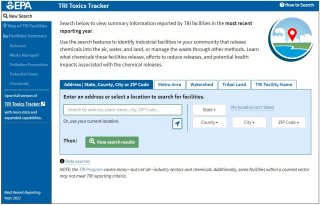
April 22, 2020
Launch of TRI Toxics Tracker
As part of EPA’s Earth Day 50th anniversary celebration, the TRI Program launched an improved search feature on the TRI website homepage giving users easier access to TRI data. The TRI Toxics Tracker features streamlined navigation and functionality, enhanced visualizations, and expanded search options.

February 11, 2020
Publication: Interactive Metal Mining Diagram
The TRI Program published its first interactive web-based industry diagram. Developed in collaboration with the metal mining industry, the webpage explains how metal mines operate and generally how and where releases of TRI-listed chemicals happen. EPA hopes to develop similar webpages about other industry sectors.
December 20, 2019
Addition of More Than 150 PFAS to the TRI Chemical List
The National Defense Authorization Act for Fiscal Year 2020 added more than 150 per- and polyfluoroalkyl substances (PFAS) to the TRI list of reportable chemicals. Certain PFAS can accumulate and stay in the human body for long periods of time. There is evidence that exposure to PFAS can lead to adverse health outcomes in humans.
June 12, 2018
Addition of Nonlyphenol Ethoxylates (NPEs) Category
A final rule added a category of 13 specific nonylphenol ethoxylates (NPEs) to the TRI list of reportable chemicals. NPEs are nonionic surfactants used in adhesives, wetting agents, emulsifiers, stabilizers, dispersants, defoamers, cleaners, paints, and coatings. EPA determined that longer-chain NPEs can break down in the environment to short-chain NPEs and nonylphenol, both of which are highly toxic to aquatic organisms.
November 28, 2016
Addition of Hexabromocyclododecane (HBCD) Category
A final rule added a hexabromocyclododecane (HBCD) category to the TRI list of reportable chemicals with a 100-pound reporting threshold. EPA determined that HBCD presents potential human health concerns for developmental and reproductive effects, is highly toxic to aquatic and land-dwelling organisms, bioaccumulates, and is persistent in the environment.
October 19-21, 2016
2016 TRI National Training Conference
EPA hosted the 2016 National Training Conference on TRI and Environmental Conditions in Communities in Washington, D.C. The conference theme was, “TRI at 30: Working Together to Reduce Toxic Releases.” At the conference, the TRI Program marked the 30th anniversary of its creation under the Emergency Planning and Community Right-to-Know Act.
November 23, 2015
Addition of 1-Bromopropane
A final rule added 1-bromopropane to the TRI list of reportable chemicals based on available data that indicate it can be reasonably anticipated to cause cancer in humans.
January 2015
New Interactive Web-Based TRI National Analysis
For the first time, EPA made the annual TRI report available in a Web-based format featuring analyses and interactive maps showing data at a state, county, city and zip code level.

May 7-9, 2014
2014 TRI National Training Conference
EPA hosted the 2014 National Training Conference on TRI and Environmental Conditions in Communities in Washington, D.C. Session topics included the TRI community engagement pilot projects, the intersection between TRI and children's health, and examples of TRI data use in the classroom.

August 2013
Mandatory Electronic Reporting Using TRI-MEweb
A final rule required all facilities that meet TRI reporting requirements to use the TRI-MEweb online reporting application to prepare and submit their reporting forms. Widespread use of TRI-MEweb has improved the quality and accuracy of TRI data and allowed EPA to get the data to the public faster.
February 2013
First TRI University Challenge
EPA launched a new initiative challenging the academic community to find innovative ways to use TRI data to promote informed decision-making among communities, researchers, manufacturers, and others. EPA selected eight proposals for the 2013-2014 school year.

January 2013
TRI Pollution Prevention (P2) Search Tool
A new online tool provided the public with direct access to TRI data on P2 practices implemented by facilities or parent companies that resulted in reductions in release and other waste management quantities of toxic chemicals. The tool lets users visually compare how different companies have managed toxic chemical waste. The tool is also a valuable resource allowing companies to learn from each other’s P2 best practices.
April 11-13, 2012
2012 TRI National Training Conference
EPA hosted the 2012 National Training Conference on TRI and Environmental Conditions in Communities in Washington, D.C. The conference theme was “Understanding the Past and Promoting a Sustainable Future.”

April 2012
Increasing Tribal Participation in the TRI Program
A final rule required TRI facilities located in Indian country to submit TRI reporting forms to EPA and the appropriate tribe, rather than to the state in which the facility is geographically located. There are approximately 377 TRI-covered facilities located on the lands of 47 different federally recognized tribes.
October 17, 2011
The TRI Program's 25th Anniversary
On the 25th anniversary of the law that created the TRI, EPA leaders and staff reflected on the program's importance.
Hear former EPA Administrator Lisa Jackson talk about the TRI Program.
Hear former Assistant Administrator Malcolm Jackson talk about the TRI Program.
November 2-4, 2010
2010 TRI National Training Conference
EPA hosted the 2010 National Training Conference on TRI and Environmental Conditions in Communities in Washington, D.C. The conference theme was, “Connecting Communities and Decision-makers with Environmental Information.” EPA began holding these conferences in the 1990s.

November 2010
National Toxicology Program Chemicals Added to TRI
A final rule added 16 new chemicals to the TRI Program. Each chemical added is “reasonably anticipated to be a human carcinogen” by the National Toxicology Program (NTP), an interagency government program that works to evaluate public health concerns.

July 28, 2010
Earliest-Ever Availability of TRI Data
For the first time, EPA made TRI data available to the public within the same month as the TRI reporting deadline, providing communities with earlier access to important toxic chemical information.
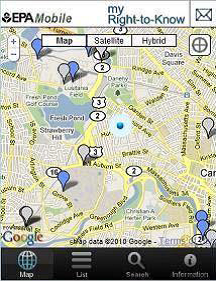
June 2010
Launch of MyRTK Mobile App
EPA launched the first TRI mobile application, “My Right to Know,” in 2010. For any location, MyRTK maps nearby facilities that report to the TRI Program, as well as facilities with EPA air, water or hazardous waste program permits. The map links to more information about the facilities. Note: EPA retired this application in late 2020 after replacing it with a new search tool.
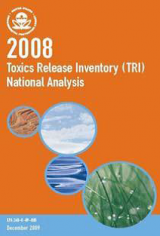
December 2009
TRI National Analysis Report Published Earlier
For the first time, EPA published the TRI National Analysis report in the same calendar year that industrial facilities reported the data. The National Analysis includes documents and webpages that provide analysis and interpretation of the most recent TRI data, including national and local trends of toxic chemical releases to the environment.
June 2009
TRI.NET Application Debuted
EPA developed the TRI.NET application to provide advanced mapping and search capabilities to TRI data users. Users can select, sort and filter TRI data; combine TRI with other data sources; and map and export results into other applications for further analysis.
April 2009
TRI Reporting Requirements Restored
The 2009 Omnibus Appropriations Act restored the more comprehensive TRI reporting requirements that were in effect prior to the 2006 Burden Reduction Rule.
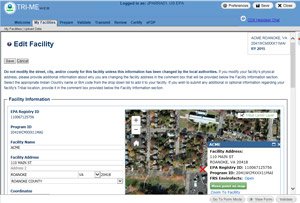
January 2008
TRI-MEweb Application Available to All Facilities
In 2008, EPA released the TRI-MEweb reporting application, allowing all TRI facilities to submit TRI data through the Internet. Since the beginning of the TRI Program, EPA has worked to streamline the TRI reporting process for facilities and simultaneously improve the quality of the data being submitted.
In the late 1980s, EPA provided facilities with software that could produce a paper reporting form or a diskette that could be mailed to EPA. In the early 2000s, EPA introduced a downloadable computer desktop application that could produce a paper reporting form, a digital file to be submitted online, or a diskette to be mailed to EPA.

May 2007
TRI Dioxin Toxic Equivalency Rule
This final rule required that TRI facilities report the mass quantity for each individual member of the dioxin and dioxin-like compounds category on a new reporting form, the Form R Schedule 1. Using the more detailed dioxin data, EPA can calculate toxic equivalent (TEQ) values to help people understand the relative toxicity of the chemical release information found in TRI.
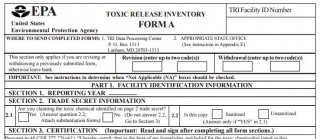
December 2006
TRI Burden Reduction Rule
This final rule expanded eligibility for TRI facilities to use Form A, a simpler reporting form with less detailed information for qualified reporters, instead of the more detailed Form R. This rule is no longer in effect due to the Omnibus Appropriations Act of 2009.
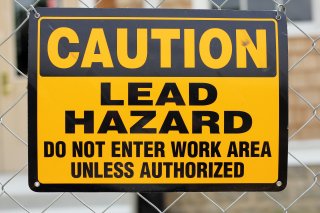
January 2001
TRI Lead and Lead Compounds as PBTs
This final rule designated lead and lead compounds as Persistent, Bioaccumulative, Toxic chemicals (PBTs), lowering their TRI reporting thresholds to 100 pounds. Lead has been shown to remain in the environment for a long time and become concentrated in the organisms exposed to it.
October 1999
PBT Chemicals Added to TRI
This final rule added seven Persistent Bioaccumulative Toxic (PBT) chemicals and two chemical categories to the TRI chemical list and lowered reporting thresholds for 18 PBTs already on the list. PBT chemicals are of particular concern not only because they are toxic but also because they remain in the environment for a long time, are not readily destroyed, and build up in body tissue.
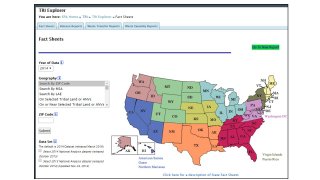
July 1998
TRI Explorer Application Debuts
EPA initially released TRI Explorer as a downloadable application for accessing TRI information. Later, TRI Explorer became an interactive Web-based tool for generating a variety of customized of TRI data reports.
TRI Explorer can help communities identify facilities and chemical disposal or other release patterns that warrant further study and analysis. Combined with hazard and exposure information, TRI Explorer can be a valuable tool for risk identification.
May 1997
Seven Industry Sectors Added to TRI
Expansion of the TRI Program continued with a final rule that applied TRI reporting requirements to metal and coal mining facilities, electric power generators, commercial hazardous waste treatment operations, solvent recovery facilities, petroleum bulk terminals and wholesale chemical distributors.

November 1994
Over 200 Chemicals Added to TRI
This final rule expanded TRI by 286 new chemicals and chemical categories, bringing the number of chemicals reportable to TRI to more than 600. This action greatly increased the amount of publicly available information on toxic chemical use at industrial facilities.
December 1993
21 Chemicals and 2 Chemical Categories Added to TRI
In response to a petition from the Governor of New York and the Natural Resources Defense Council, EPA added certain chemicals from the Resource Conservation and Recovery Act (RCRA) list of hazardous wastes to the TRI chemical list. (58 FR 63500, December 1, 1993)
August 3, 1993
Executive Order 12856: Federal Compliance with Right-to-Know Laws and Pollution Prevention Requirements
Based on EPCRA and the Pollution Prevention Act of 1990, President Clinton issued an executive order requiring federal agencies to report any toxic chemicals they release into the environment. The executive order also required federal agencies to reduce pollution as much as possible.
November 1990
Pollution Prevention Act Expands TRI Program
The Pollution Prevention Act (PPA) expanded the scope of information collected under the TRI Program to include data on how facilities manage toxic chemicals through recycling, energy recovery and treatment processes.

December 1989
First EPA-Initiated Addition of Chemicals
EPA added nine chemicals to the TRI chemical list that reflected toxicity determinations made under Section 102 of the Comprehensive Environmental Response, Compensation, and Liability Act (CERCLA) of 1980.

June 1989
First National TRI Report for Reporting Year 1987
EPA published “The Toxics Release Inventory: A National Perspective,” a report summarizing the first year of TRI data. The public had never had access to such comprehensive toxic chemical release information.
July 1988
First TRI Reporting Deadline
On July 1, 1988, industrial facilities that met TRI reporting requirements were required to submit TRI reporting forms for chemical releases that occurred during calendar year 1987. More than 19,000 manufacturing facilities submitted over 74,000 individual chemical forms to EPA.
June 1988
First Petition to Modify the TRI Chemical List Granted
In response to three petitions from industry, EPA published a final rule to delete titanium dioxide from the TRI chemical list after determining that it did not meet the EPCRA Section 313 listing criteria. This was the first time EPA granted a petition to modify the TRI chemical list. (53 FR 23108). EPA responded to more than 50 TRI petitions over the next three decades.

November 1986
First TRI Chemical Petition
EPA received a petition requesting the addition of a category of inorganic fluorides to the TRI chemical list. Under EPCRA Section 313, the public can petition EPA to add chemicals to or delete chemicals from the TRI list. EPA denied the inorganic fluorides petition in a Federal Register notice published on May 29, 1987. (52 FR 20142).

October 1986
TRI Program Created Under Emergency Planning and Community Right-to-Know Act
In response to growing concerns about local preparedness for chemical emergencies and the availability of information on hazardous substances, Congress passed the Emergency Planning and Community Right-to-Know Act (EPCRA). President Reagan signed EPCRA into law on October 17, 1986. Section 313 of EPCRA created the Toxics Release Inventory to provide communities with information about toxic chemical releases from industrial facilities into the environment and to support informed decision-making by industry, government, non-governmental organizations and the public.

December 1984
Union Carbide Disaster: Bhopal, India
On December 2, 1984, a cloud of extremely toxic methyl isocyanate gas escaped from a Union Carbide Chemical plant in Bhopal, India. Thousands of people died that night in what is widely considered to be the worst industrial disaster in history. Thousands more died later as a result of their exposure, and survivors continue to suffer with permanent disabilities.
The incident raised public concern about toxic chemical storage, releases and emergency response. It led to the passage of the Emergency Planning and Community Right-to-Know Act (EPCRA) under the 1986 Superfund Amendments and Reauthorization Act. Section 313 of EPCRA established the Toxics Release Inventory.
